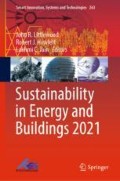Abstract
Climate change is becoming a dominant concern for advanced countries. The Paris Agreement sets out a global framework for sustainable development performance configuring all climate action related policies. Fast control of CO2 emissions necessarily involves cities since they are responsible for 70 percent of greenhouse gas emissions. A common framework for urban policy impact assessment must be based on architectural design tools and common data repositories for standard digital building models. Many Neighbourhood Sustainability Assessment (NSA) tools have been developed but the growing availability of open data repositories for cities, together with big-data sources (provided through Internet of Things repositories), allow accurate neighbourhood simulations, or in other words, digital twins of neighbourhoods. These digital twins are excellent tools for policy impact assessment. This chapter provides a generic approach for a simple neighbourhood model developed from building physical parameters which meets relevant assessment requirements.
Access this chapter
Tax calculation will be finalised at checkout
Purchases are for personal use only
References
Peng, Y., Lai, Y., Li, X., Zhang, X.: An alternative model for measuring the sustainability of urban regeneration: the way forward. J. Clean. Prod. 109, 76–83 (2015). https://doi.org/10.1016/j.jcle-pro.2015.06.143
Salat, S.: Cities and Forms, on Sustainable Urbanism. CSTB Urban Morphology Laboratory, Hermann Editeurs: Paris, France, Chapter 3, pp. 241–256 (2011)
Mavi, R.K., Gengatharen, D., Mavi, N.K., Hughes, R., Campbell, A., Yates, R.: Sustainability in construction projects: a systematic literature review. Sustainability 2021, 13 (1932). https://doi.org/10.3390/su13041932
Kim, R., Lim, M.-K., Roh, S., Park, W.-J.: Analysis of the characteristics of environmental impacts according to the cut-off criteria applicable to the streamlined life cycle assessment (S-LCA) of apartment buildings in South Korea. Sustainability 13, 2898 (2021). https://doi.org/10.3390/su13052898
Sharifi, A., Murayama, A.: A critical review of seven selected neighborhood sustainability assessment tools. Environ. Impact Assess. Rev. 38, 73–87 (2013). https://doi.org/10.1016/j.eiar.2012.06.006
Bragança, L., Mateus, R., Koukkari, H.: Building sustainability assessment. Sustainability 2, 2010–2023 (2010). https://doi.org/10.3390/su2072010
Bruce-Hyrkäs, T., Pasanen, P., Castro, R.: Overview of whole building life-cycle assessment for green building certification and ecodesign through industry surveys and interviews. Procedia CIRP 69, 178–183 (2018). https://doi.org/10.1016/j.procir.2017.11.127
Homayouni, H., Dossick, C.S., Neff, G.: Three pathways to highly energy efficient buildings: assessing combinations of teaming and technology. J. Manag. Eng. 37(2) (2021). https://doi.org/10.1061/(ASCE)ME.1943-5479.0000883
Rehhausen, A., Hanusch, M., Fischer, T.B.: Multi-project-based strategic environmental assessment: practice in Germany. In: Handbook on Strategic Environmental Assessment (Political Science and Public Policy). Elgar on-line (2021). https://doi.org/10.4337/9781789909937
Obrecht, T.P., Röck, M., Hoxha, E., Passer, A.: BIM and LCA integration: a systematic literature review. Sustainability 12, 5534 (2020). https://doi.org/10.3390/su12145534
Zangheri, P., Armani, R., Pietrobon, M., Pagliano, L.: Identification of cost-optimal and NZEB refurbishment levels for representative climates and building typologies across Europe. Energy Effic. 11, 337–369 (2018). https://doi.org/10.1007/s12053-017-9566-8
TABULA: Webtool on EU Building Typologies. Available online: https://epi-scope.eu/building-typology/tabula-webtool/ (accessed on 4 April 2021)
EU Building Stock Observatory Datasets: Available online: https://data.europa.eu/eu-odp/en/data/dataset/building-stock-observatory (accessed on 4 April 2021)
Li, J., Wang, Y., Ni, Z., Chen, S., Xia, B.: An integrated strategy to improve the microclimate regulation of green-blue-grey infrastructures in specific urban forms. J. Clean. Prod. 271, 122555 (2020). https://doi.org/10.1016/j.jclepro.2020.122555
Guinee, J.B.: Handbook on Life Cycle Assessment Operational Guide to the ISO Standards. Kluwer Academic Publishers, Amsterdam, The Netherlands (2002)
Wang, H., Chen, W.: Gaps between pre-2020 climate policies with NDC goals and long-term mitigation targets: analyses on major regions. Energy Procedia 158, 3664–3669 (2019). https://doi.org/10.1016/j.egypro.2019.01.894
Piasecki, M.: Practical implementation of the indoor environmental quality model for the assessment of nearly zero energy single-family building. Buildings 9, 214 (2019). https://doi.org/10.3390/buildings9100214
Escrivá-Escrivá, G., Álvarez-Bel, C., Peñalvo-López, E.: New indices to assess building energy efficiency at the use stage. Energy Build. 43, 476–484 (2011). https://doi.org/10.1016/j.enbuild.2010.10.012
Ortega Madrigal, L., García-Prieto Ruiz, A., Serrano Lanzarote, B., Soto Francés, L.: Catálogo de tiplogía edificatoria residencial. España, Ámbito (2016)
Ballarini, I., Corgnati, S.P., Corrado, V.: Use of reference buildings to assess the energy saving potentials of the residential building stock: the experience of TABULA project. Energy Policy 68, 273–284 (2014). https://doi.org/10.1016/j.enpol.2014.01.027
Ravetz, J.: State of the stock-What do we know about existing buildings and their future prospects? Energy Policy 36(12), 4462–4470 (2008). https://doi.org/10.1016/j.en-pol.2008.09.026
Theodoridou, I., Papadopoulos, A.M., Hegger, M.: Statistical analysis of the Greek residential building stock. Energy Build. 43(9), 2422–2428 (2011). https://doi.org/10.1016/j.enbuild.2011.05.034
Dascalaki, E.G., Droutsa, K., Gaglia, A.G., Kontoyiannidis, S., Balaras, C.A.: Data collection and analysis of the building stock and its energy performance—an example for Hellenic buildings. Energy Build. 42(8), 1231–1237 (2010). https://doi.org/10.1016/j.enbuild.2010.02.014
Fracastoro, G.V., Serraino, M.: A methodology for assessing the energy performance of large scale building stocks and possible applications. Energy Build. 43(4), 844–852 (2011). https://doi.org/10.1016/j.enbuild.2010.12.004
Swan, L.G., Ugursal, V.I.: Modeling of end-use energy consumption in the residential sector: a review of modeling techniques. Renew. Sustain. Energy Rev. 13(8), 1819–1835 (2009). https://doi.org/10.1016/j.rser.2008.09.03
García-Pérez, S., Sierra-Pérez, J., Boschmonart-Rives, J.: Environmental assessment at the urban level combining LCA-GIS methodologies: a case study of energy retrofits in the Barcelona metropolitan area. Build. Environ. 134, 191– 204 (2018). https://doi.org/10.1016/j.buildenv.2018.01.041
Author information
Authors and Affiliations
Corresponding author
Editor information
Editors and Affiliations
Rights and permissions
Copyright information
© 2022 The Author(s), under exclusive license to Springer Nature Singapore Pte Ltd.
About this paper
Cite this paper
Calabuig-Moreno, R., Temes-Cordovez, R., Orozco-Messana, J. (2022). Neighbourhood Digital Modelling of Energy Consumption for Carbon Footprint Assessment. In: Littlewood, J.R., Howlett, R.J., Jain, L.C. (eds) Sustainability in Energy and Buildings 2021 . Smart Innovation, Systems and Technologies, vol 263. Springer, Singapore. https://doi.org/10.1007/978-981-16-6269-0_45
Download citation
DOI: https://doi.org/10.1007/978-981-16-6269-0_45
Published:
Publisher Name: Springer, Singapore
Print ISBN: 978-981-16-6268-3
Online ISBN: 978-981-16-6269-0
eBook Packages: Intelligent Technologies and RoboticsIntelligent Technologies and Robotics (R0)

